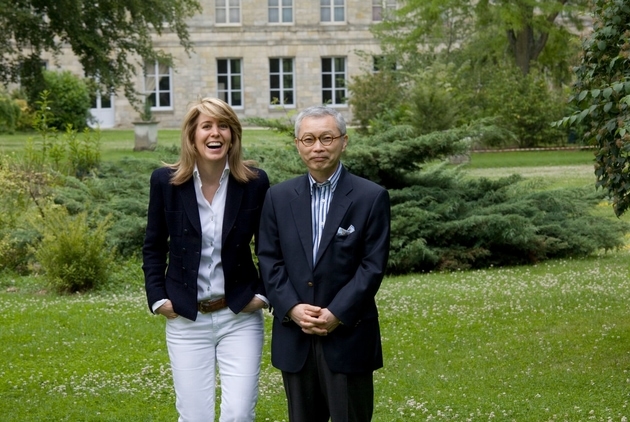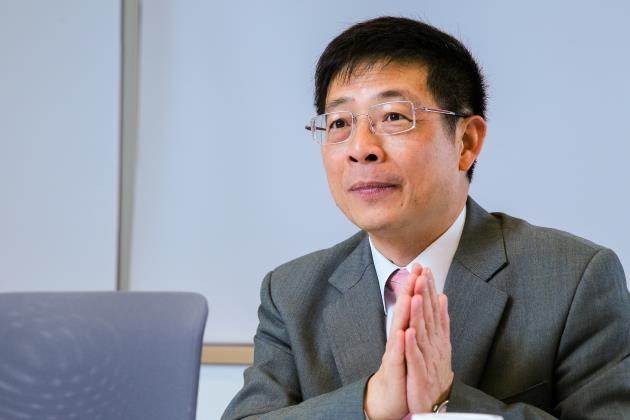Taiwan’s Blue Ocean Shift
Debunking the ‘Top-down’ Model

Source:Blue Ocean Shift Team
Some Taiwanese executives have embraced a “blue ocean” strategy of seeking out new markets rather than getting stuck in fiercely competitive “red ocean” markets. CommonWealth Magazine helped two of them ask the scholars behind the concept questions on how it can be better applied.
Views
Debunking the ‘Top-down’ Model
By Pei-Hua LuFrom CommonWealth Magazine (vol. 658 )
Thirteen years ago, W. Chan Kim and Renée Mauborgne swept the world with a new vision for corporate strategy in the book “Blue Ocean Strategy.” Last year, they presented a set of strategic tools in their new book “Blue Ocean Shift: Beyond Competing: Proven Steps to Inspire Confidence and Seize New Growth” to help companies apply the strategy in a changing world.
Chaney Ho, an executive director with industrial automation specialist Advantech Co., and Joseph Huang, president of E.Sun Financial Holding Co., are both fans of the authors and the concept.
Ho says that when the blue ocean strategy was first introduced, he put it into practice by analyzing and revising his company’s strategy.
Ho was looking to compete with China-based EVOC Intelligent Technology, which was founded by a former Advantech employee in China and has received financial support from China’s government. Carefully applying the blue ocean strategic map, he analyzed the differences between Advantech and EVOC and decided to eliminate the company’s advertising budget, allocating the resources instead to strengthen the stability of Advantech’s products and relationships with its big clients. (Read: Advantech Launches Counter Attack from Europe)
Huang said he was particularly impressed by the authors’ emphasis on the need for a humanistic process, or “humanness,” in executing a blue ocean shift.
After speaking with Ho and Huang, CommonWealth Magazine asked Kim and Mauborgne some of the questions that popped up as the two executives applied the strategy to their businesses. Here are excerpts of the conversation.
CommonWealth Magazine: It has been more than 10 years since “Blue Ocean Strategy” was published. Do you think “Blue Ocean Strategy” is still a comprehensive tool for companies nowadays? More than 10 years later, have you revised the theory? If so, why?
W. Chan Kim & Renée Mauborgne: What has happened in the past decade is consistent with our observations about the pattern of value innovation and new market creation. Tech companies have brought significant changes to the financial industry with profound implications for consumers and the society at large.
Yet underlying the creation of a new market and new demand was still value innovation rather than technological innovation or disruption.
Those successful FinTech companies have used new technologies to address the pain points of users caused by traditional financial services and in turn create breakthroughs in value for consumers. Their innovations, therefore, were firmly anchored in value. We should also remember that there were companies that eventually failed despite the bleeding-edge technologies they possessed because they did not offer innovative value to consumers.
This is an important point for traditional financial institutions to appreciate, as once they see new technologies as enabling tools to help them achieve value innovation, they can take an active part in shaping the future outlook of the industry rather than being disrupted by these technologies.
 Renée Mauborgne and W. Chan Kim (Source: Blue Ocean Shift Team)
Renée Mauborgne and W. Chan Kim (Source: Blue Ocean Shift Team)
On a more general level, new developments in the past decade have made our theory more relevant than ever before. For most organizations, it is more imperative than before to pursue blue ocean shift. The market today is much more crowded than 10 years ago due to increased participation of global players from emerging economies and the emergence of tools for global communications, transactions and advertising that generally make it faster and easier to become a global player.
The rise of emerging economies and the huge market demand they represent also call on organizations to come up with offerings that are both high-value and affordable to these markets characterized by relatively low per-capita income on the one hand, and increasingly sophisticated consumer tastes on the other.
Moreover, the rising influence and use of social media have shifted the power and credibility of voice from organizations to individuals, making it increasingly impossible for organizations to over-market their me-too offerings.
There has hardly been a time in history when achieving innovative value at lower cost became a pressing need in so many industries, sectors, countries and regions.
CW: According to the book, a blue ocean and red ocean are clearly different concepts. However, companies sometimes feel confused over whether they are situated in a blue or red ocean. Are there signs or indicators you can recommend to help companies identify their situation?
Kim & Mauborgne: When you are in the red ocean, normally you will find yourself trapped in cutthroat competition. Profit margins are declining, downward pressure on price is mounting, and products are getting commoditized in your industry.
In order to evaluate accurately and systematically whether your offerings are in the red ocean, the first blue ocean tool you want to use is the Strategy Canvas – a one-page visual analytical that depicts the way an organization configures its offering to buyers in relation to those of its competitors.
The horizontal axis of the strategy canvas specifies the key factors the industry competes on and invests in; the vertical axis captures the offering level buyers receive or experience for each of an industry’s key competing factors. This tool allows you to draw and compare the strategic profiles of your offering and those of your competitors in a picture; see and understand where you and your competitors are currently investing; the product, service and delivery factors the industry is competing on; and what customers receive from existing competitive offerings.
This exercise pushes you to take a step back from the detail you are typically enmeshed in and clearly see your industry’s defining contours. When the strategic profiles of industry players are converging, the industry is turning into a red ocean of bloody competition. If you are in such a situation, it is time to think about a blue ocean shift.
A second tool you want to use here is the Pioneer-Migrator-Settler (PMS) Map. Pioneers are businesses or offerings that represent value innovations. A value innovator stands apart from the competition by offering a leap in value. Settlers are “me-too’s” that offer value imitation. Migrators represent a value improvement over the competition and may even be best in class but they do not offer innovative value.
While the as-is strategy canvas enables you to evaluate where a particular offering of yours stands in the industry, the PMS Map allows you to plot all your existing offerings on the map and assess the strength of your organization’s portfolio of offerings. When you do the exercise, if you have many “me-too” settlers in your portfolio, making a blue ocean shift is imperative for your company in order to create new momentum for profitable growth in the future. Conversely, if you have quite a few pioneers in the portfolio, they are your blue oceans and the sources of your company’s profitable growth. (Read: Taiwanese Food Makers Choosing Blue Ocean over Red Ocean)
CW: The financial industry tends to be highly regulated. Financial institutions often identify new business opportunities but cannot take advantage of them because of regulations. What can they do when they face such situations?
Kim & Mauborgne: A fundamental principle of the blue ocean approach is to look across existing boundaries of competitions. Indeed regulations in the financial industry are especially heavy. But outside the traditional industry, financial innovations have been happening. The new FinTech sector is rapidly taking shape. Retail companies are offering banking services based on their large consumer networks. These, of course, are themselves the results of reconstruction across market boundaries.
 E.Sun Financial Holding Co. President Joseph Huang (Source: Chien-Ying Chiu)
E.Sun Financial Holding Co. President Joseph Huang (Source: Chien-Ying Chiu)
Cooperating with New Market Participants
If traditional financial service players see the regulations in their own field as constraints, all these new developments will be missed business opportunities for them. And they will likely see those new players as posing threats and disruptions.
They should understand, however, that these new players are also subject to regulatory and other constraints in their own fields, which have limited their ability to profit on scale beyond the narrow functions and segments they have initially focused on. It is therefore an opportunity for traditional financial service companies to embrace the new innovative factors by partnering with those new players so that, together, they can hopefully overcome regulatory boundaries in their respective silos and take an active role in reshaping the landscape of the financial industry and setting the industry on a trajectory of new growth.
CW: Is there a difference when you help companies or governments to implement blue ocean strategies in Western and Asian markets?
Kim & Mauborgne: Generally speaking, there has been great commonality between Western and Asian organizations when it comes to making a blue ocean shift. The main difference – at the risk of overgeneralization and exaggeration – is that Western organizational culture tends to be horizontally oriented whereas Asian organizations are generally more vertically oriented and hierarchical. This characteristic has two implications for Asian organizations.
First, managers in Asian countries could think that a top-down approach is efficient in producing the desired performance outcomes faster through hierarchical enforcement, whereas going through a blue ocean shift process can be tedious and time consuming. (Read: Opinion: How Western Entrepreneurs Can Make It in Asia)

(Read: 2 Pieces of Paper = 1 Smooth Succession)
Top-down Approach Inefficient
But here we need to consider the total amount of time needed for a strategic transformation, which includes not only the formulation of strategy but also its execution. Without going through the proper process and ensuring buy-in and support at different levels of the organization, execution can take a much longer time. Hence, the total amount of time needed for the shift under the hierarchical approach is likely to take much longer.
Second, while the blue ocean shift process can be initiated at any level of the organization, for Asian companies, more than for their Western counterparts, top management’s engagement in and support for the initiative from the very start is likely to make a shift move more efficient as this will set the tone and build the momentum in the entire organization.
CW: We have found Taiwanese companies usually create internal competition between different units or divisions rather than to build a blue ocean team when they attempt transformations. What are the pros and cons of doing that?
Kim & Mauborgne: Creating inner competition between different units or divisions can be a good and effective way to improve operational efficiency under a given strategy. But the competitive divides also tend to create silos or even cause a degree of tension between units/divisions. Hence, the inner competition approach often is not suitable for driving innovative blue ocean projects. (Read: Can Taiwan Set Course for the 'Blue Ocean'?)
The typical challenge a company may encounter in using these tools is that out of a sense of urgency for making the needed blue ocean shift, the management might feel that going through all these steps and processes can be time-consuming and therefore would rather give top-down orders and ask its people to dive into the technical process of conceiving and making a blue ocean shift.
However, without addressing upfront the basic human truths that reside within each of us, attempts to drive organizations to become more creative and innovative are likely to fail. Indeed, humanness builds psychological understanding into the strategic process and strengthens our confidence to act by eliciting our emotional engagement. It relaxes us and inspires us to tap into our curiosity and creativity, which is critical for reshaping and reimagining industry boundaries.
You need to construct a team where you gather representatives from all the functions and organizational levels that will play a key role in bringing a new offering to market. That would usually include someone from HR, IT, marketing, finance, manufacturing, R&D, and sales, as well as someone on the front lines, like a call center staff member or someone who works on the store floor. Instead of encouraging competition between units/divisions, therefore, at this point you need to build collective wisdom and united efforts across them. (Read: The Secret of the World’s Most Competitive Nation)
Once the strategy for making a blue ocean shift is created and execution is well underway, the method of inner competition can be relevant as it will drive different units to move more efficiently towards the newly agreed strategic goal.
“Slasher” has become a popular new term. It describes people making good use of their multiple strengths in their careers. Could the blue ocean strategy be implemented by individuals? Have you seen any such cases?
Kim & Mauborgne: Yes, the blue ocean method can certainly be applied to value innovating personal development.
To value innovate your career, for example, the first question you need to ask yourself is: is my career really stalling? The ‘as-is’ strategy canvas can give you the answer. Plotting your career profile against your peers is useful as it shows the extent to which you stand apart (or don’t stand apart) in the job market. If your strategic profile doesn’t stand apart from that of your peers, you’re a me-too.
To make a blue ocean shift, you need to consider what factors of competition you can eliminate, reduce, raise and create that will help you to stand apart. You can do this by filling in the Eliminate-Reduce-Raise-Create (ERRC) Grid. These four actions allow you to break away from the competition by reconstructing factors across conventional boundaries of competition.
Finally, draw your ‘to-be’ strategy canvas. This is the strategy canvas that depicts the ideal state you want to reach. This will show you in one simple visual how to stand apart from the competition and make a blue ocean shift in your career.
At the personal level, making a blue ocean shift is about setting your own rules rather than benchmarking the competition and being just another me-too.
A telling example is that of Mina Boström Nakicenovic, a former swim champion, who, after a 27-year break and with limited time to train, won gold and silver medals in the Swedish National Masters Championship. To achieve these results, Mina had consciously applied the blue ocean tools to analyzing what the competition was focusing on and what unique strength and technique she should work on in order to stand apart.
Mina found that good swimmers tended to focus on the short-distance and freestyle categories in the competition. Using the four actions framework of blue ocean shift, she eliminated these categories for herself and focused on the 200-meter backstroke. And instead of training intensively and for long hours to get back into the best possible shape, given the limited amount of time she had, she focused on the turning technique, which was critical to increasing speed in backstroke swimming. Her achievement testified to the success of this strategy.
Translated by Luke Sabatier
Edited by Tomas Lin
Additional Reading
♦ Synnex Technology Leverages ‘Deep Cultivation’ for Explosive Growth
♦ TSMC’s Unsung Weapon
♦ Taiwanese Textile Industry's New Chance: Ethiopian Farmers + U.S. Machines







